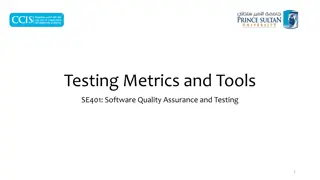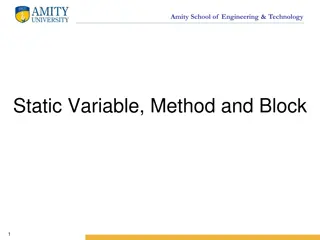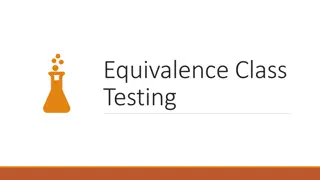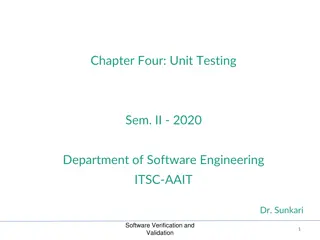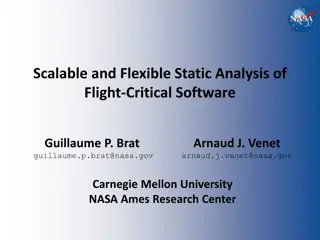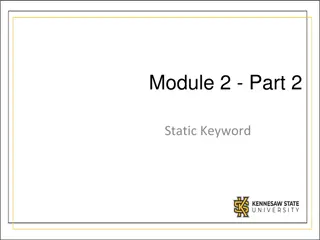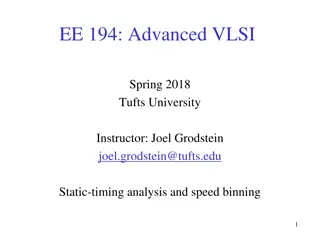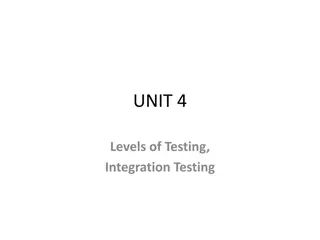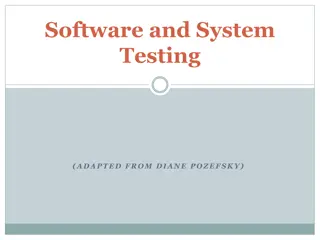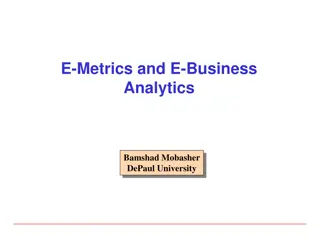Static GNSS Techniques and Products for Geospatial Applications
This educational material provides insights into static GNSS techniques, products, and their societal benefits. It covers topics such as distinguishing static GNSS techniques, understanding different products, and the capabilities of static GNSS stations. The content explores the Network of the Amer
3 views • 20 slides
Static Analysis Techniques Overview
Explore static analysis techniques such as syntactic analysis, dataflow analysis, and model checking. Understand the concept of basic blocks in static analysis and their boundaries. Dive into the opportunities provided by static analysis in summarizing program behavior without executing it.
9 views • 27 slides
Electricity Concepts: From Atoms to Static Electricity
This content delves into the basics of electricity, covering topics such as atoms, charges, static electricity, simple circuits, and more. Learn about the difference between naturally occurring and human-harnessed electricity, explore the concept of charges in objects, and discover how static electr
5 views • 14 slides
Comparison Between Static and Dynamic Program Instrumentation
The difference between static and dynamic program instrumentation lies in when the analysis or measurement probes are inserted into a program. Static instrumentation occurs before the program is run and is more closely associated with proactive software evaluation. Dynamic instrumentation, on the ot
5 views • 14 slides
Software Testing Metrics and Tools
Software testing metrics play a crucial role in evaluating the quality and progress of the testing process. Metrics provide valuable insights into the readiness, quality, and completeness of a product. By measuring attributes such as defects, testing efficiency, and productivity, organizations can m
4 views • 100 slides
Fundamentals of Software Testing Explained
Software testing is a critical process to ensure that software applications meet requirements and are free of defects. It involves various activities such as test planning, analysis, design, implementation, and execution. Testing approaches like the Bing bang approach and Total Quality Management ar
1 views • 48 slides
Software Testing Foundation Level - Static Testing Quiz by Uwe G. hl
This quiz focuses on static testing in software development, covering topics such as roles in formal reviews, activities in review planning, types of review processes, benefits of static testing, and checklist-based review scenarios. Test your knowledge on static testing concepts with these practice
2 views • 20 slides
Static Variables and Methods in Java
Static variables in Java belong to the class rather than instances of the class and are initialized only once at the start of execution. They can be accessed directly by the class name. Similarly, static methods can access static variables directly without creating an object. This content explains t
3 views • 20 slides
Equivalence Class Testing and Its Application in Software Testing
Equivalence class testing is a software testing technique that involves dividing input values into classes for effective testing coverage. Equivalence classes are defined mathematically as subsets of a given set, ensuring partitioning and mutual exclusivity. By applying equivalence partitioning, tes
3 views • 21 slides
Uganda's Successes in Reaching Men with HIV Testing Through Assisted Partner Notification Program
Uganda has successfully implemented an Assisted Partner Notification (APN) program to reach men for HIV testing, addressing the gender gap in testing rates. By utilizing various approaches such as index testing, self-testing, and social network testing, Uganda has achieved significant success in tar
0 views • 12 slides
Importance of Static Unit Testing in Software Development
Unit testing is a crucial aspect of software development, involving both static and dynamic approaches. Static unit testing, such as code inspections and walkthroughs, helps in finding errors early, reducing costs and improving reliability. By examining code behavior against requirements and involvi
0 views • 27 slides
Software Testing Foundation Level: Testing Throughout the SDLC Quiz
Explore key concepts in software testing throughout the Software Development Lifecycle (SDLC) with a quiz covering topics like white-box testing in acceptance testing, component testing vs. system testing, and regression testing purposes. Enhance your understanding of testing methodologies with samp
5 views • 17 slides
Importance of Software Testing in Preventing Catastrophic Failures
Software testing is crucial in ensuring the reliability and safety of software systems, as highlighted by catastrophic failures such as the Ariane 5 rocket incident and the Therac-25 radiation therapy machine disasters. These examples underscore the importance of thorough testing in identifying and
1 views • 42 slides
Testing Approach in SCREAM for E3SM Fall All-Hands 2019
Major effort is focused on verification and testing in SCREAM for the E3SM Fall All-Hands. The initiative includes unit testing, property testing, regression testing, and leveraging various tools like Cmake, Python, Jenkins, AutoTester, and GitHub for Continuous Integration (CI). The emphasis is on
1 views • 21 slides
The Wonders of Electricity: From Appliances to Static Energy
Explore the fascinating world of electricity through everyday activities like making toast and doing laundry, and learn about static electricity and how it can make hair stick to balloons and sweaters. Remember to plug things in for power and discover the magic of static electricity generated by rub
1 views • 5 slides
Static Routing in Network Infrastructure Workshops
Explore the concepts of static routing in networking workshops, covering Unix and Cisco network interface configurations, static routes, default routes, and advantages and disadvantages of static routing. Learn about IP routing configuration, assignment of IPv4 addresses, and FreeBSD network interfa
5 views • 37 slides
Static Analysis in Flight-Critical Software
Explore the challenges and advancements in static analysis for flight-critical systems, focusing on the importance of soundness and assurance through tools like IKOS, MathWorks PolySpace, and ASTREE. Learn about the limitations of testing in detecting critical errors and how static analysis can offe
0 views • 23 slides
Static Electricity in Spray Painting of Cars
Spray painting in the automotive industry utilizes static electricity to create an efficient and effective painting process. By charging the paint particles and the object being painted, the paint adheres better, resulting in a more even coating. This method not only speeds up the painting process b
1 views • 5 slides
Using Decision Trees for Program-Based Static Branch Prediction
This presentation discusses the use of decision trees to enhance program-based static branch prediction, focusing on improving the Ball and Larus heuristics. It covers the importance of static branch prediction, motivation behind the research, goals of the study, and background on Ball and Larus heu
0 views • 36 slides
Static Electricity: Two Kinds of Charges
Explore the concept of static electricity and the two types of charges - positive and negative - present in matter. Learn how charges can be separated through rubbing or pulling objects, leading to the buildup of static electricity. Unravel the properties of particles in matter and the significance
0 views • 16 slides
Testing in Space Simulation Facilities: A Comprehensive Analysis
This webinar delves into testing in space simulation facilities, comparing the requirements at different stages of space missions such as launch, cruise, and operations. Presented by Miracle Israel Nazarious, it covers topics including space qualification testing involving static load, vibration, th
0 views • 12 slides
C++11 Features and Design Patterns by Mark Redekopp
Explore the key concepts of C++11 features and design patterns explained by Mark Redekopp, focusing on static members, unique ID assignment for students, and the use of static data members in classes. Discover best practices for ensuring unique IDs for students and efficiently utilizing static membe
0 views • 24 slides
Procedural Decomposition and Static Methods in Programming
Understanding procedural decomposition and static methods is essential in programming to reduce redundancy, organize code effectively, and manage complexity. Procedural decomposition involves dividing a problem into methods, while static methods help in code reuse and managing complexity. By designi
0 views • 18 slides
Testing in Software Engineering
In the previous session, we discussed various aspects of software engineering, including modeling with UML diagrams, such as activity diagrams, use case diagrams, sequence diagrams, state diagrams, and class diagrams, as well as architecture patterns. Testing was emphasized as a key aspect, highligh
0 views • 35 slides
Gray Box Testing in Software Development
Gray Box Testing is a software testing technique that involves testing the software with partial knowledge of its internal workings. It combines aspects of White Box Testing and Black Box Testing, allowing testers to check both the presentation layer and the code part of an application. Gray Box Tes
0 views • 14 slides
Static Variables and Methods in Object-Oriented Programming
Explore the concept of static variables and methods in object-oriented programming. Learn how static attributes are shared among all instances of a class, enabling a single copy of the variable to be used across objects. Discover examples and illustrations demonstrating the use of static variables f
0 views • 18 slides
Introduction to Static Analysis in C.K. Chen's Presentation
Explore the fundamentals of static analysis in C.K. Chen's presentation, covering topics such as common tools in Linux, disassembly, reverse assembly, and tips for static analysis. Discover how static analysis can be used to analyze malware without execution and learn about the information that can
1 views • 54 slides
Event-Based Race Detection in Android Apps Using SIERRA
The research discusses the significance of detecting event-based races in Android applications due to concurrency issues. It emphasizes the prevalence of such bugs in high-severity Android issues and motivates the need for static detection methods. The proposed approach, SIERRA, is introduced as the
2 views • 30 slides
Requirements-Based Testing in Software Development
Dive into the world of requirements-based testing in software development, exploring main concepts, test levels, testing roles, and the importance of testing your solution and modeling case. Learn about test cases, different testing activities, and the significance of acceptance testing in identifyi
0 views • 16 slides
Benefits of Probabilistic Static Analysis for Improving Program Analysis
Probabilistic static analysis offers a novel approach to enhancing the accuracy and usefulness of program analysis results. By introducing probabilistic treatment in static analysis, uncertainties and imprecisions can be addressed, leading to more interpretable and actionable outcomes. This methodol
0 views • 11 slides
Guidelines for HIV Testing During Pregnancy and Postpartum
These guidelines recommend HIV testing during pregnancy, at delivery, and postpartum. Testing should be done early in pregnancy and again in the third trimester. Expedited testing during labor is required for certain patients, and syphilis testing is recommended. Pre-exposure and post-exposure proph
0 views • 18 slides
Static Timing Analysis in Advanced VLSI Design
Static timing analysis is a crucial aspect of VLSI design, helping predict chip performance before fabrication. This article explores the importance of static timing analysis, its effectiveness, and the limitations of dynamic simulation tools like SPICE. Learn about the challenges in testing critica
0 views • 76 slides
Comprehensive Overview of Fault Modeling and Fault Simulation in VLSI
Explore the intricacies of fault modeling and fault simulation in VLSI design, covering topics such as testing philosophy, role of testing in VLSI, technology trends affecting testing, fault types, fault equivalence, dominance, collapsing, and simulation methods. Understand the importance of testing
0 views • 59 slides
Unit Testing in Software Engineering
Concept Software is a discipline comprising various code pieces. Testing these codes together is complex but vital in Software Engineering. The process includes early testing like unit tests, pairwise/multiple component testing, module testing, integration testing, user tests, alpha tests, beta test
1 views • 6 slides
Integration Testing and Levels of Testing
Explore the importance of integration testing in software development, covering topics such as traditional testing levels, the SATM system, goals and purposes of integration testing, testing level assumptions and objectives, software process overview, various approaches to integration testing, and t
0 views • 39 slides
Static Electricity and Electrostatics
Static electricity is a result of electric charge buildup on insulating materials due to friction, causing electrons to transfer and create a charge difference. This can lead to phenomena like a balloon sticking to a wall. The origin of static charge lies in the electrons and protons within atoms, w
0 views • 9 slides
Importance of Software and System Testing
Understanding the critical role of software and system testing in identifying and fixing errors before they lead to major failures. Various types of testing such as functional, usability, performance, and reliability testing are essential to ensure the quality of software products. Different classif
0 views • 52 slides
Why Every Dev Team Needs Static Analysis
This presentation delves into the importance of static analysis in software development, highlighting the detrimental impact of bugs, the advantages of testing and static analysis, debunking common myths, and the characteristics of a good static analysis tool. It addresses the costly repercussions o
0 views • 23 slides
C++ Code Safety using static Analysis Principles
C++ has traditionally prioritized performance, but the demand for strong safety guarantees is growing. Explore how static analysis can improve code safety, bridging the gap between Rust and C++. Discover the importance of correctness and the benefits of leveraging static analysis techniques for earl
0 views • 43 slides
E-Metrics & E-Business Analytics Overview
Web usage mining and e-business analytics play a crucial role in understanding and predicting online customer behavior. This involves answering important questions related to visitor origin, on-site activities, customer satisfaction, outcomes, content preferences, profitability analysis, and more. D
0 views • 28 slides




